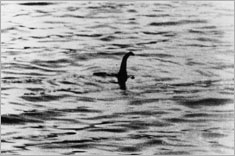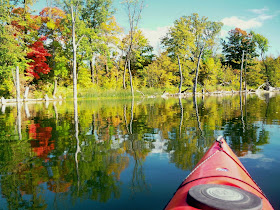I am therefore a ready believer in relics, legends, and local anecdotes of goblins and great men, and would advise all travellers who travel for their gratification to be the same. What is it to us whether these stories be true or false, so long as we can persuade ourselves into the belief of them and enjoy all the charm of the reality? -- Washington Irving
A body of water can be a downright terrifying place. Looking straight down into its murky depths any sailor, fisherman or kayaker can't help but wonder what lurks below. Unexplored storm-tossed seas and our deepest unforgiving lakes expose our innermost fears. Add a blend of cultural folklore and eyewitness accounts and our imaginations and curiosity are sparked by an opportunity into the unknown as we scan the water's surface for sea monsters
The centuries-old legends of lake creatures and modern-day tales of sea monsters are irresistible mysteries to us all especially when there is no way to disprove they exist. Science says they don't. But, seeing is believing. Here are few places you just might want to paddle (if you dare) this Halloween or anytime, for your chance to glimpse a sea monster.
Loch Ness, Scotland.
 |
| © Hulton Archive/Getty Images |
"About 30 feet in length, and nearly 10 feet in height from the water to the top of the back." Val Moffat told NOVA about his face to encounter in 1990, "It was a bright, sunny day, the water was bright blue, and it really showed up against it. It was a mixture of browns, greens, sludgy sort of colors. I looked at it on and off for a few seconds, because I was driving. Must have seen it three or four times, and the last time I looked, it was gone!"
Lake Windermere, England.
Called Bownessie, the younger and less famous of Britain's sea monster lives in shadow its famous cousin, the fabled Loch Ness Monster in northern England. In 2011, two Brits told the Daily Mail that they spotted three or four mysterious humps emerging from the water while they were kayaking.
"I thought it was a dog," Tom Pickles said, "Then I realized it was much bigger and moving really quickly. Each hump was moving in a rippling motion and it was swimming fast. I could tell it was much bigger underneath from the huge shadow around it."
"Its skin was like a seal's, but its shape was abnormal," said his paddling partner Sarah Harrington it's not like any animal I've ever seen before. We saw it for about 20 seconds. It was petrifying. We paddled back to the shore straight away,"
But, not before getting a fuzzy camera phone picture.
 |
| Heaven Lake |
The lake is the deepest and the largest crater lake in on the China and North Korea border. It is also the home of Lake Tianchi Monster. The first reported sighting came back 1903 when a large mouthed and buffalo-like creature attacked three people. They were only saved after the creature was shot six times and retreated under the water. More than hundred people reported seeing two monsters chasing each other in 1962 while in 2007, a Chinese TV station shot 20 minutes of video of six unidentified creatures.
"They could swim as fast as yachts and at times they would all disappear in the water. It was impressive to see them all acting at exactly the same pace, as if someone was giving orders," said TV reporter Zhuo Yongsheng, "Their fins, or maybe wings were longer than their bodies."
Lake Utopia, New Brunswick Canada
Local legend that has span centuries, says that the lake is inhabited by a sea monster known as“Old Ned." It seems the monster has a dislike for canoeists. One of the first sightings came a long time ago when two Maliseet Indians were canoeing on the lake and suddenly a terrifying eel-like monster with a large head and bloody jaws appeared chasing them to the other end. 1891, a logger gave this description of a creature, "It was dark red in colour, the part showing above the water was 20 feet long and as big around as a small hogshead; it was much like a large eel."
In 1996, you guess it canoeist spotted the creature again, measuring “30 to 40 feet” as it swam just under the surface, “up and down” not “side to side," as eels would swim.
Lake Champlain, New York, Vermont & Quebec
Champy is the American cousin to Loch Ness' Nessie. Described by Captain Crum 1819 in an account in the Plattsburgh Republican as a black monster, about 187-feet-long and with a head resembling a seahorse, that reared more than 15 feet out of the water. He claimed the monster also had three teeth, eyes the color of "a pealed onion," adorned with a white star on its forehead and "a belt of red around the neck."
In July 1873, Clinton County's Sheriff, Nathan H. Mooney, reported seeing an "enormous snake or water serpent." A month later, the steamship W.B. Eddy had a close encounter Champy by running into it. According to the passengers on board, the ship nearly capsized, which prompted circus showman P. T. Barnum offered a reward of $50,000 for "hide of the great Champlain serpent. Ever since approximately 600 people have claimed to have seen Champy.
Lake Norman, North Carolina
Just last summer, a 35-year-old Mecklenburg County man told CryptoZoology he spotted a “dinosaur-like creature” while traveling on a boat with friends. He claimed the creature was about 10-feet-long and reminiscent of the mythical Loch Ness monster.
Sightings date back nearly 50 years on the largest man-made lake in North Carolina and have become more common in recent years. A few dozen witnesses have posted their sightings on LakeNormanMonster.com, like this one from John Edds of Huntersville, “I was on a boat when a huge force from below knocked me overboard,” he wrote, “I got back on to my boat when I saw a Nessie-like sea monster swimming away from me. It looked about 15 feet long.” While another post came from a man and his girlfriend who saw the creature while jet skiing who wrote, “We both saw a large body come to the surface. It was dark, and shiny in some spots but was at least 14-ft long. We both were scared to death. She is now scared to swim there."
Lake Pepin, Minnesota & Wisconsin
The monster called Pepie is described as a large, serpent-like creature that lives in the shadowy depths of Lake Pepin, a lake occurring naturally at the widest part of the Mississippi River. First witnessed by river rafters in 1867, Pepie made an even a bigger splash four years later when the Wabasha County Sentinel, reported, “a marine monster between the size of an elephant and rhinoceros, moving with great rapidity.”
Sightings of the creature have continued over the years contributing to the local folklore. It is said that on a moonlit night in 1922, young Ralph Samuelson saw Pepie skimming across the lake and thought, “If a large aquatic creature can skim across the water’s surface, why can’t I?” which led to the idea behind the sport of water skiing and Lake City, Minn., is now forever known as “the birthplace of water skiing."
In 2008 businessman Larry Nielson made monster watching profitable by offering a $50,000 reward for conclusive proof of Pepie's existence as a ploy to garner tourism in the Lake City area. So far no one has collected the bounty.
Lake Tahoe, Nevada & California
Tales of an up to 80-foot-long jet black serpentine creature dates back to the Gold Rush when members of area Indian tribes warned settlers about a monster dwelling in an underwater tunnel beneath Cave Rock in the famed alpine lake.
In 1865, I. C. Coggin a got first-hand look at the creature from a treetop. In 1897, he told the San Francisco Call newspaper this chilling account.
 |
| Lake Tahoe |
Tales of an up to 80-foot-long jet black serpentine creature dates back to the Gold Rush when members of area Indian tribes warned settlers about a monster dwelling in an underwater tunnel beneath Cave Rock in the famed alpine lake.
In 1865, I. C. Coggin a got first-hand look at the creature from a treetop. In 1897, he told the San Francisco Call newspaper this chilling account.
“I heard a sound as if the dead limbs trees, willows and alders that grew in the canyon were being broken and crushed. Soon the monster appeared, slowly making his way in the direction where I was hidden in the tree top and passed on to the lake within 50 feet of where I was, and as his snakeship got by I partly recovered from my fright and began to estimate his immense size."
Not stopping there he continued with his eerie tale, "After his head passed my tree about 70 feet, he halted and reared his head in the air fifty feet or more. His monstrous head was about 14 feet wide and his large eyes seemed to be almost eight inches in diameter and shining jet black and seemed to project more than half the size from his head. The neck was about ten feet and the body in the largest portion must have been twenty feet in diameter."
The headline in the paper screamed Lake Tahoe's Big Serpent and the word of Tessie spread just like the saying, "There is gold in them hills!" Over the decades, off-duty police officers, fishermen, bartenders and kayak instructors have all reported seeing an unusually large creature swimming in the lake.
In the 1970's it is said that renowned, French oceanographer, Jacques Cousteau wanted to see for himself. In a mini-submarine, while exploring the depths of the lake he reportedly encountered something so horrifying that all he could not even bring himself to talk about it saying, "The world wasn't ready for what was down there!"
 |
| Courtesy of The Daily Inter Lake |
So while these lake monsters have evaded our detection, they have captured our imaginations providing us with an opportunity to have an adventure searching for them.
A few other famous lake monsters: Bear Lake Monster, Bear Lake, Utah & Idaho, Manipogo, Lake Manitoba, Canada, Cressie, Crescent Lake, Newfoundland, Memphre, Lake Memphremagog, Vermont, Nahuelito, Nahuel Huapi Lake, Argentina, Ogopogo, Okanagan Lake, British Columbia, Ray, Raystown Lake , Pennsylvania,Bessie Lake Eerie, Vermont & Quebec, Storsjöodjuret, Lake Storsjön, Sweden and Lake Van Monster Lake Van, Turkey.












